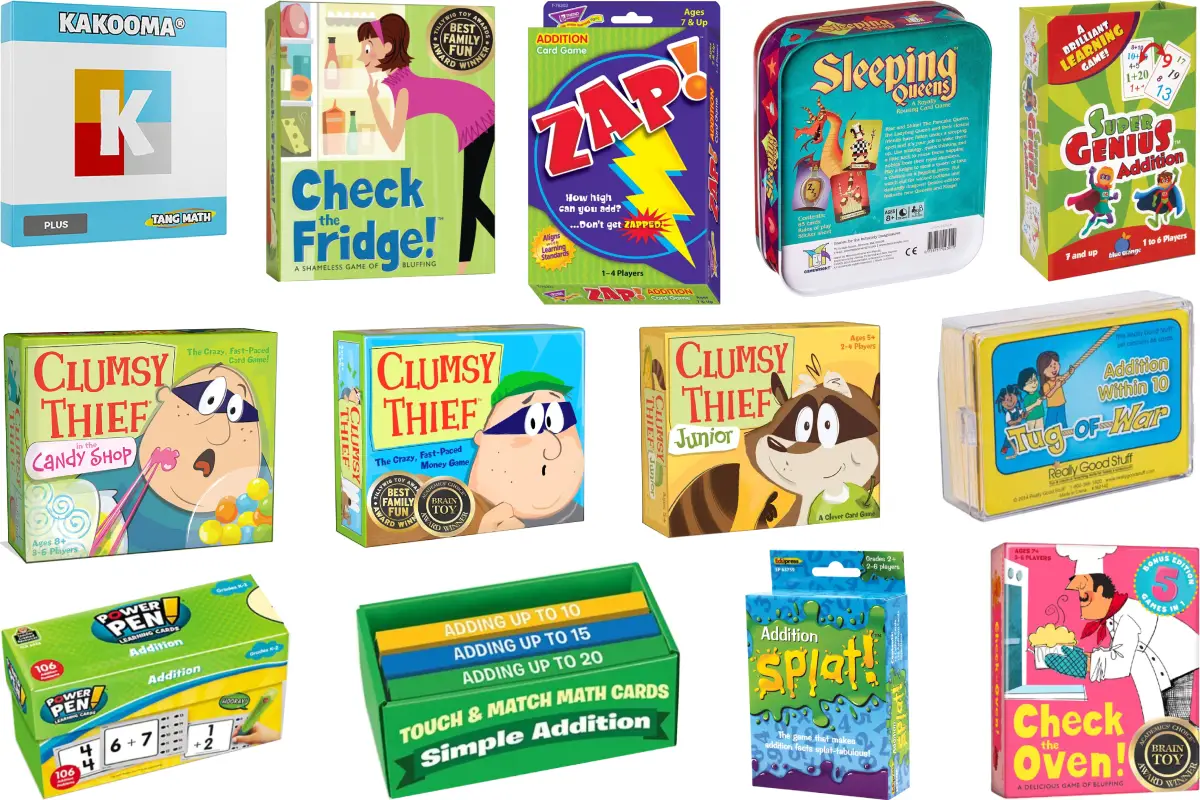This post contains affiliate links.
Addition is one of the first math operations that kids learn. Good thing that there are addition card games that you can use as early as kindergarten. Here are some of the best games I found.
This post consists of card games that can be used to add up:
- Numbers 0-12, like Check the Oven
- Numbers 0-20, such as Touch and Match Simple Addition Cards
- Numbers 0-50, for example, Sleeping Queens
- Numbers 0-100 like Clumsy Thief Money Game
Addition Card Games Comparison Table
| Game | Scope | Age | Players | For | Price | Rating |
| Clumsy Thief Junior | 0-10 | 4-7 | 2-4 | Families, Teachers | $$ | ★★★★☆ |
| Tug of War- Addition Within 10 | 0-10 | 5-7 | 2-5 | Teachers | $$ | ★★★☆☆ |
| Math Splat! Game: Addition | 0-12 | 7-8 | 2-6 | Teachers | $$ | ★★★☆☆ |
| Check the Oven | 0-12 | 7+ | 3-6 | Families, Teachers | $$$ | ★★★☆☆ |
| Clumsy Thief in the Candy Shop | 0-20 | 8+ | 3-6 | Families, Teachers | $$ | ★★★☆☆ |
| Splash Addition Game | 0-20 | 6-7 | 1-4 | Teachers | $$ | ★★★☆☆ |
| Touch and Match Simple Addition Cards | 0-20 | 4-6 | 1-4 | Families, Teachers | $$$ | ★★★★★ |
| Check The Fridge | 0-25 | 8+ | 3-6 | Families, Teachers | $$ | ★★★★☆ |
| Zap | 0-50 | 1-4 | Families, Teachers | $ | ★★★★☆ | |
| Sleeping Queens | 0-50 | 8+ | 2-5 | Families | SS | ★★★★☆ |
| Kakooma | 0-100 | 7-19 | 2-4 | Teachers | $$ | ★★★★☆ |
| Clumsy Thief Money Game | 0-100 | 8+ | 3-6 | Families, Teachers | $$ | ★★★★★ |
| Addition Power Pen! Quiz Cards | 0-100 | 5-7 | 1-4 | Teachers | $$ | ★★★☆☆ |
| Super Genius | 0-100 | 7+ | 1-6 | Parents, Teachers | $$ | ★★★★★ |
Addition Card Games for Primary School
The card games in this list are good at helping children master addition facts with varying difficulty and gameplay options.
Clumsy Thief Junior Math Game (Melon Rind)

★★★★☆
For Parents and Teachers | Age: 4-7 | 2-4 Players | Game Duration: 15 minutes
Teach your kindergarten child to count to 10 and add numbers using Clumsy Thief Junior Math Game . This game has 76 colorful cards divided into:
. This game has 76 colorful cards divided into:
- Food cards with numbers 0-10
- Thief cards for stealing stacks
- Trap cards for catching thief cards
In this game, players try to restack food and catch the thief using trap cards. They make stacks by combining cards that are equal to 10. They can also steal the top card of another player to make another stack. The game ends when the drawing deck is gone.
I give this game four stars because:
- The cards have the written number and the exact number of items as it (example: 2 has two pears)
- The rules are easy to follow
- The game can be adapted to your child’s skill level
Tug of War Addition (ReallyGoodStuff)
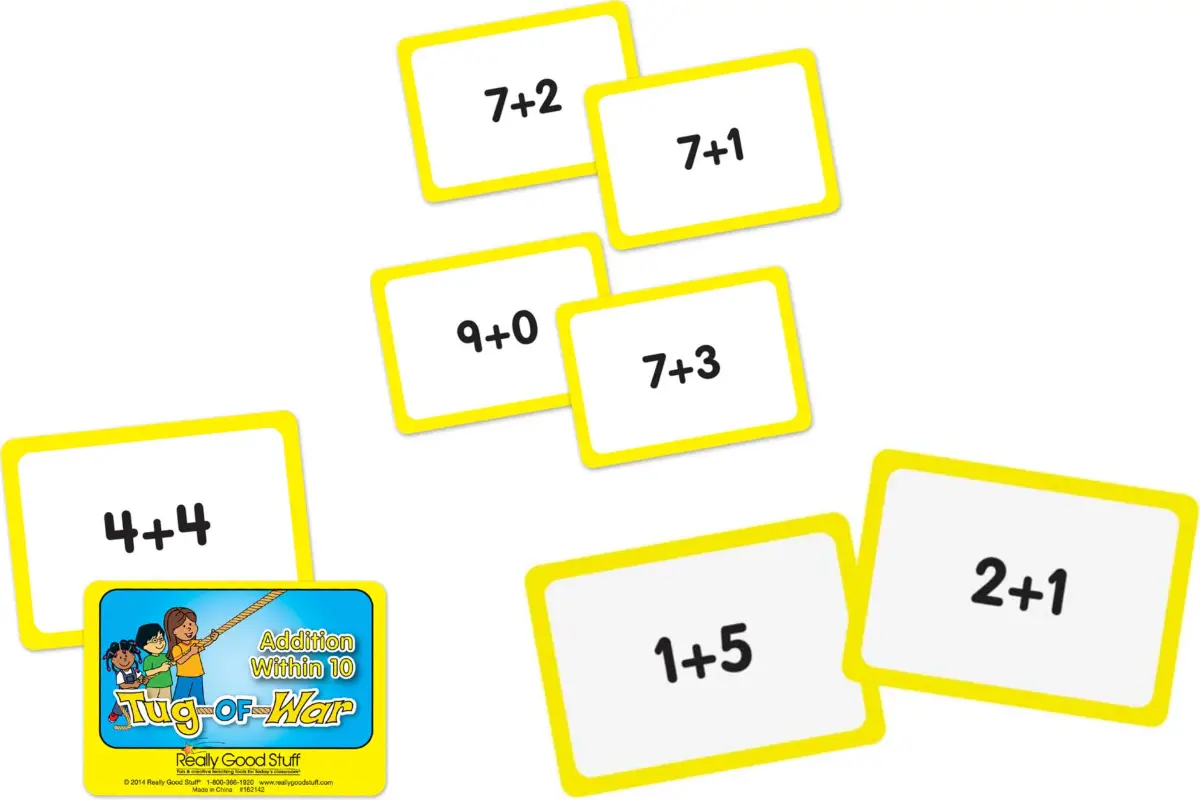
★★★☆☆
For Parents and Teachers | Age: 5-7 | 2-5 Players | Game Duration: 15 minutes
Children can practice adding numbers within 10 using Tug of War Addition . This set contains 66 addition problem cards.
. This set contains 66 addition problem cards.
If you are not familiar with Tug of War rules, here’s how to play this game:
- Deal the cards evenly among players and have them place the cards in a pile facedown.
- Players turn over the top card, then answer the addition problem.
- The player with the largest sum in each round keeps all the cards.
- The player with the most cards wins.
This game is suitable for children who are starting to add one-digit numbers. I recommend playing this game at home and school because the gameplay is fast.
Math Splat Game: Addition (Edupress)

★★★☆☆
For Teachers | Age: 7-8 | 2-6 Players | Game Duration: 20 minutes
Math Splat Game: Addition is a matching game that teaches addition facts through 12. This set has three color-coded decks with 50 addition problem cards and 25 calling cards for each deck.
is a matching game that teaches addition facts through 12. This set has three color-coded decks with 50 addition problem cards and 25 calling cards for each deck.
Here is how to play this game:
- Deal 6 cards to each player.
- The caller reads the sum, and the players have to find the corresponding addition problem.
- If they find the matching card, the player must shout, “Splat,” give the answer and flip the card over. (If two cards match the sum, flip both cards over.)
- The first player to flip all their cards shall be declared the winner.
For one-on-one practice, I suggest using this set in a memory game. First, remove addition problem cards with the same sum, then mix all the cards from all decks.
Overall, this game is excellent for 2nd to 3rd-grade children because it is easy to set up and play.
Check The Oven! Math Game (Melon Rind)
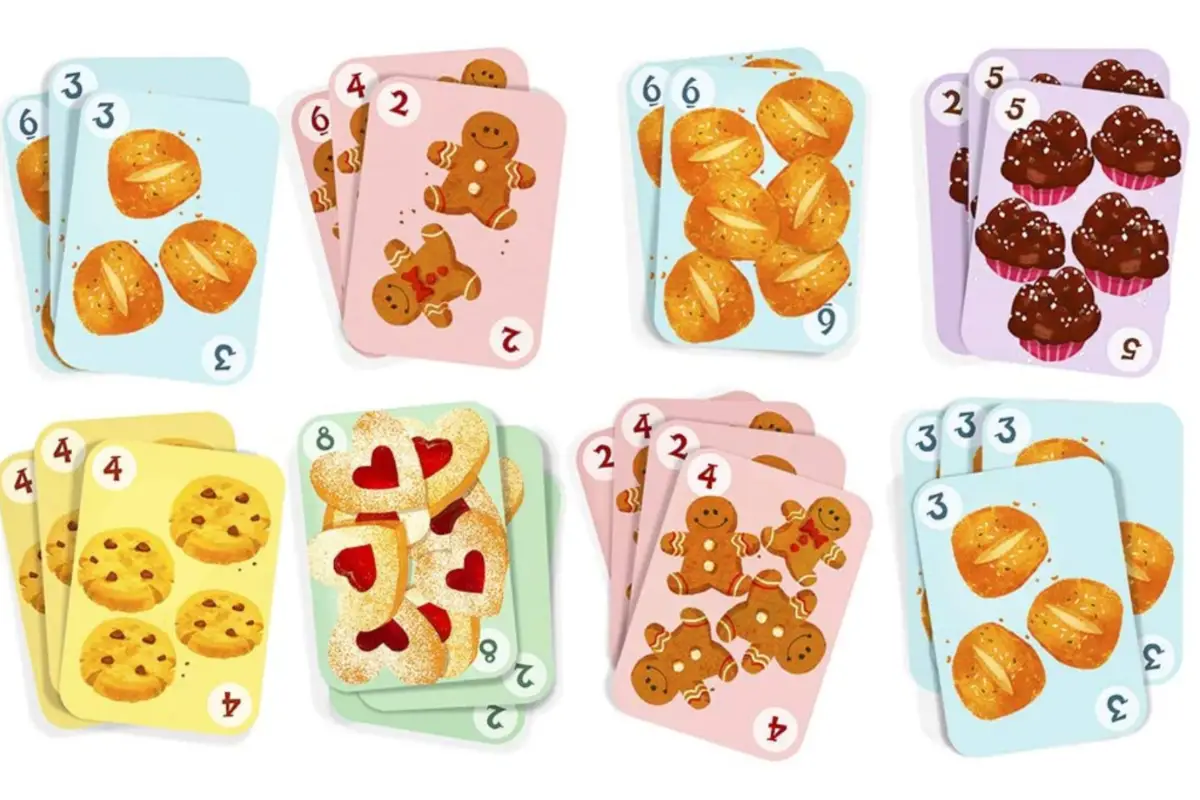
★★★☆☆
For Parents and Teachers | Age: 7+ | 3-6 Players | Game duration: 15 minutes
Check the Oven! Math Game is a bluffing game where players collect treat cards that add to 12 and avoid broken pies.
is a bluffing game where players collect treat cards that add to 12 and avoid broken pies.
To play.
- Each player receives five cards.
- The first player asks for a treat card, and the others may offer a treat or the broken pie card.
- Then, the requesting player selects one card and tries to add it to make 12. If they find a match, they place it on board; otherwise, the next player gets their turn.
- The game ends when someone has no more cards to play
This game deserves three stars because:
- It has visually attractive and durable cards.
- The game is short, easy to teach, and play.
- There are five different ways to use the deck
However, children may rely on illustrations as clues instead of trying to add. And it needs at least three players.
Clumsy Thief in the Candy Shop (Melon Rind)
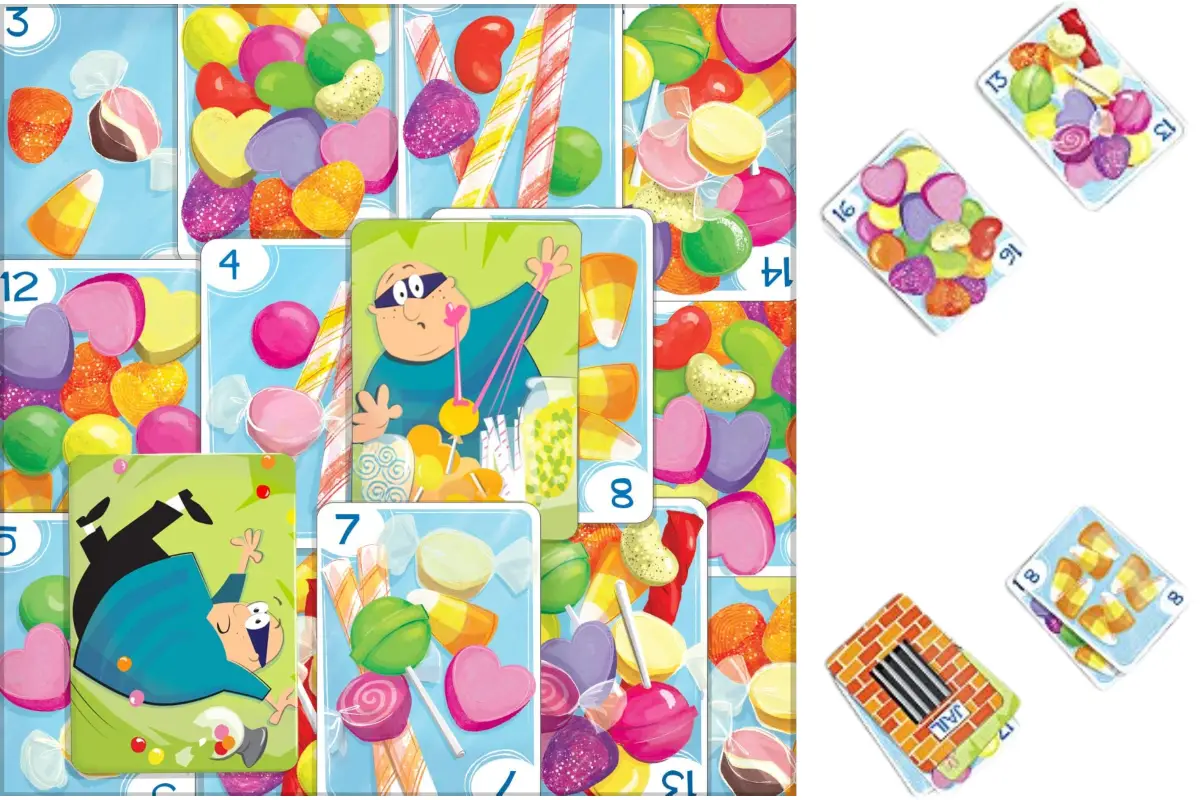
★★★☆☆
For Parents and Teachers | Age: 8+ | 3-6 Players | Game Duration: 15 minutes
In Clumsy Thief in the Candy Shop , children learn to add numbers within 20. And the game’s goal is to have as many cards as possible.
, children learn to add numbers within 20. And the game’s goal is to have as many cards as possible.
Each player gets seven cards. Then, they need to match two cards equal to 20 and put them on the table. Opponents may steal cards by taking the top card (of another player) to make a 20 or using the thief card.
For younger players, start with multiples of 5 and 10. And for students with stronger addition skills, ask them to use three cards to make 20 for more challenging gameplay.
I recommend this game because children can learn variations of adding up to 20 using sturdy and beautiful cards.
Splash Addition Game (Lakeshore Learning)

★★★☆☆
For Teachers | Age: 6-7 | 2-4 Players | Game Duration: 15 minutes
Splash Addition Game is a pool-themed game where players take turns drawing cards and answering the addition problems aloud. If they solve the equations correctly, they keep the card; however, if they get the Splash! Card, they start the game all over again.
is a pool-themed game where players take turns drawing cards and answering the addition problems aloud. If they solve the equations correctly, they keep the card; however, if they get the Splash! Card, they start the game all over again.
The first player to collect ten cards is the winner.
This card set comprises 100 addition problems and offers two skill levels: easy and difficult.
Getting the Splash card may annoy beginners, so I suggest removing it to avoid losing their interest in the game.
Touch and Match Simple Addition Cards (Lakeshore Learning)
★★★★★
For Parents and Teachers | Age: 4-6 | 1-4 Players | Game Duration: 15 minutes
Mastering addition within 20 is easier with Touch and Match Simple Addition Cards . This set comprises 40 tactile cards and 40 number cards.
. This set comprises 40 tactile cards and 40 number cards.
This card set is helpful to children with zero knowledge in addition because they learn by counting and touching the texture on the picture cards. It is also self-correcting, so playing solo is not a problem.
Teachers may use this set in the classroom because it offers increasing difficulty. The game is divided into four-leveled pockets where children learn to add numbers up to 5,10, 15, and 20. It is ideal to use in one-on-one math sessions.
Check the Fridge! Math Game (Melon Rind)
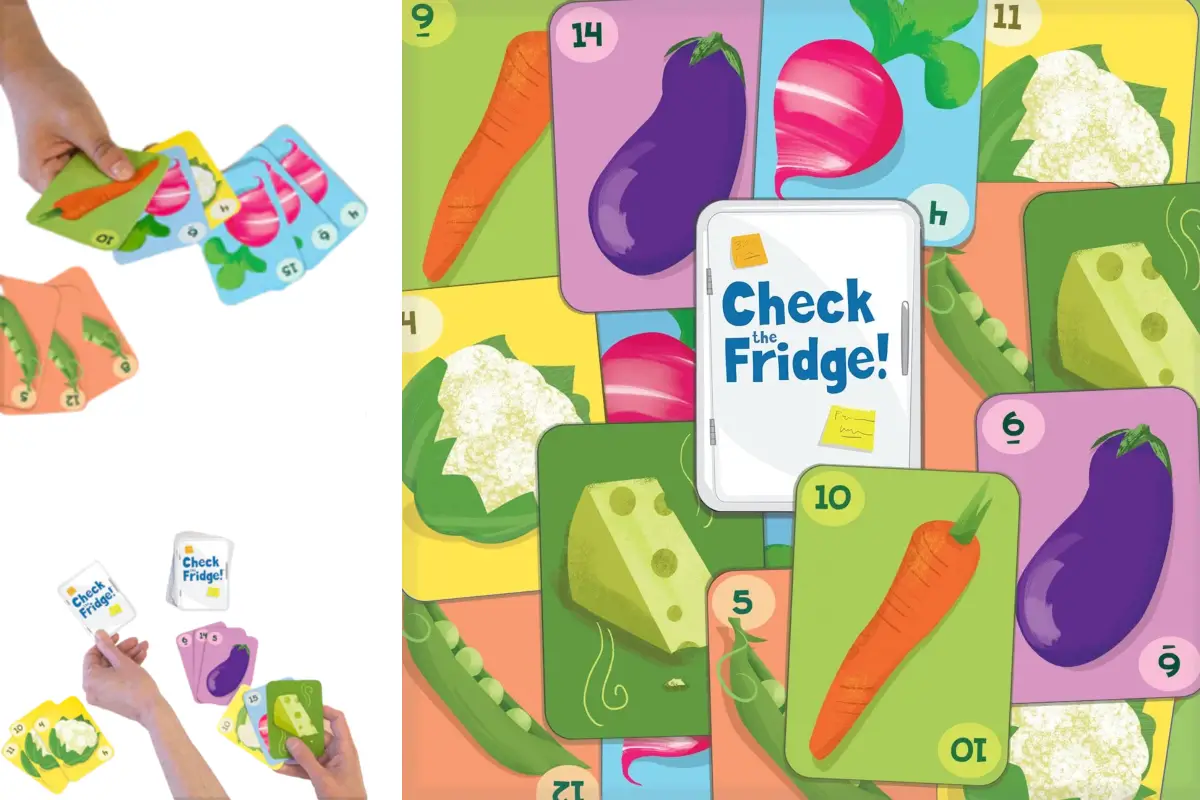
★★★★☆
For Parents and Teachers | Age: 8+ | 3-6 Players | Game duration: 15 minutes
Check the Fridge! Math Game is a bluffing game featuring 48 beautifully illustrated cards.
is a bluffing game featuring 48 beautifully illustrated cards.
In this 15-minute game, players must collect cards of the same food that add up to 25. The game ends when a player runs out of cards to play. The player with the most points wins.
This is an exciting game for players skilled in adding three numbers equal to 25. However, it may be too fast and overwhelming for beginners or young players.
I recommend this game because it develops plenty of skills, including:
- ability to add numbers to 25
- memorize vegetables
The biggest disadvantage of this game is the player count, as at least three players are needed to play.
Zap (Flat River Group)

★★★★☆
For Parents and Teachers | Age 7-18| 1-4 Players | Game Duration: 15 minutes
In Zap , children build their addition skills by drawing cards and adding the numbers to get 50. This set has 100 playing cards and an instruction guide.
, children build their addition skills by drawing cards and adding the numbers to get 50. This set has 100 playing cards and an instruction guide.
I like this set because:
- The cards contain dots equal to the card number, which is helpful for beginners
- The rules are simple and can be modified to match your child’s skills
- It can be used solo without the zap cards for a casual play
I am deducting one star from its rating because the design of the back side of the number cards is too similar to the Zap card, which makes it confusing sometimes.
Sleeping Queens Grab It-Time to Rhyme (The Learning Journey)

★★★★☆
For Parents | Age 8+ | 2-5 Players | Game Duration: 20 minutes
Sleeping Queens is a kid-invented game where players race to wake as many queens as they can. Game contents include 85 cards:
is a kid-invented game where players race to wake as many queens as they can. Game contents include 85 cards:
- 16 queens
- Ten kings
- Four jesters
- Four knights
- Four sleeping potions
- Three wands
- Three dragons
- Four sets of numbers 1-10
The rules vary depending on how many players are involved, and instructions are included in the set.
The pros of this game:
- The cards are attractive and durable
- It offers good practice for math skills such as counting, identifying patterns, and simple addition
I recommend this fast-paced game because it encourages children to create as many addition equations as possible to draw more luck in getting new cards to win the game.
You can learn more about Sleeping Queens in this review and instructions video.
in this review and instructions video.
Kakooma (Tang Math)
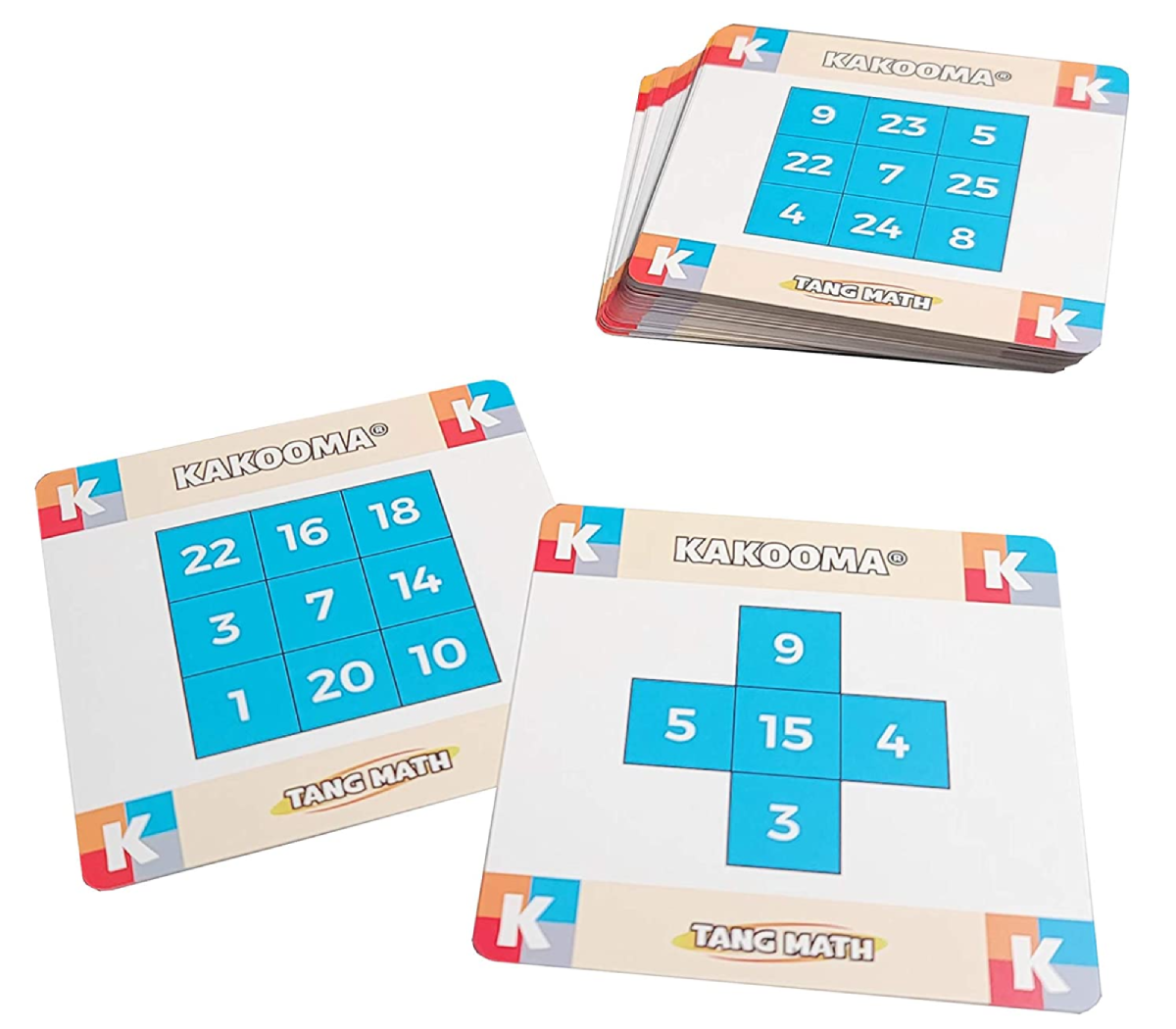
★★★★☆
For Teachers| Age: 7-19| 1-4 Players | Game Duration: 15 minutes
Kakooma has 40 double-sided cards that can be used to practice addition and multiplication.
has 40 double-sided cards that can be used to practice addition and multiplication.
Each addition card contains five numbers, where three of them belong to a number bond fact family composed of addends and a sum. (For example, 8+2=10.) And the goal is to identify the number bonds in the card before another player does.
I recommend this game because it can be introduced to children from first to fourth grade. The rules can also be changed to accommodate your child’s skill level.
Learn the official instructions of Kakooma in this video.
Clumsy Thief Money Game (Melon Rind)
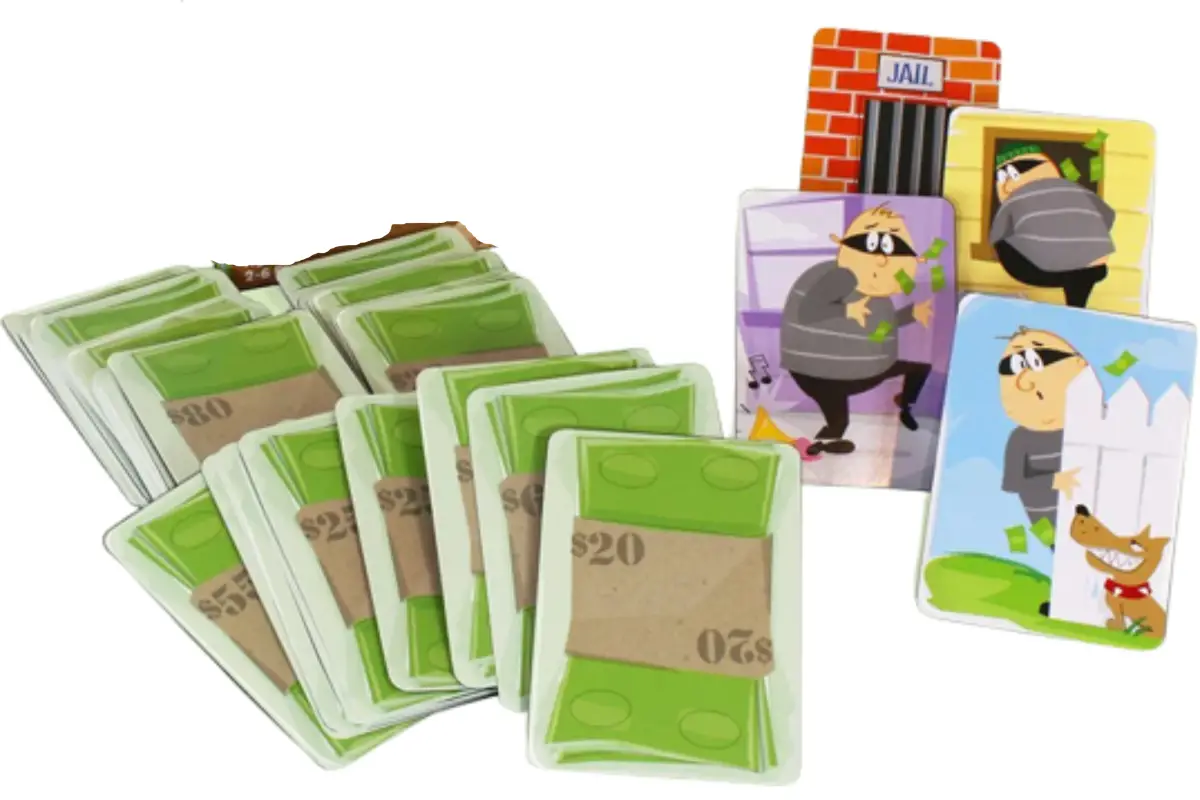
★★★★☆
For Parents and Teachers | Age: 8+ | 2-6 Players | Game duration: 15 minutes
In Clumsy Thief Money Game, players add and snatch money to earn points and win.
The game follows the same rules as Clumsy Thief Junior Math Game , except players need to add two cards to get $100.
, except players need to add two cards to get $100.
The things I like:
- Beautiful artwork on cards
- Variations can be introduced to increase replay value or match the player’s addition skills (for example, parents may remove the cards that end with the number 5 so that beginners can practice adding by 10s first)
This game works well with 2-6 players, but younger children may enjoy a 2-player game more because the turns are slower.
I recommend Clumsy Thief Money Game because each player has an equal chance of winning, and children learn to add numbers to 100 without noticing it.
Here is a game overview and review from Tom Vasel.
Addition Power Pen! Quiz Cards (Lakeshore Learning)
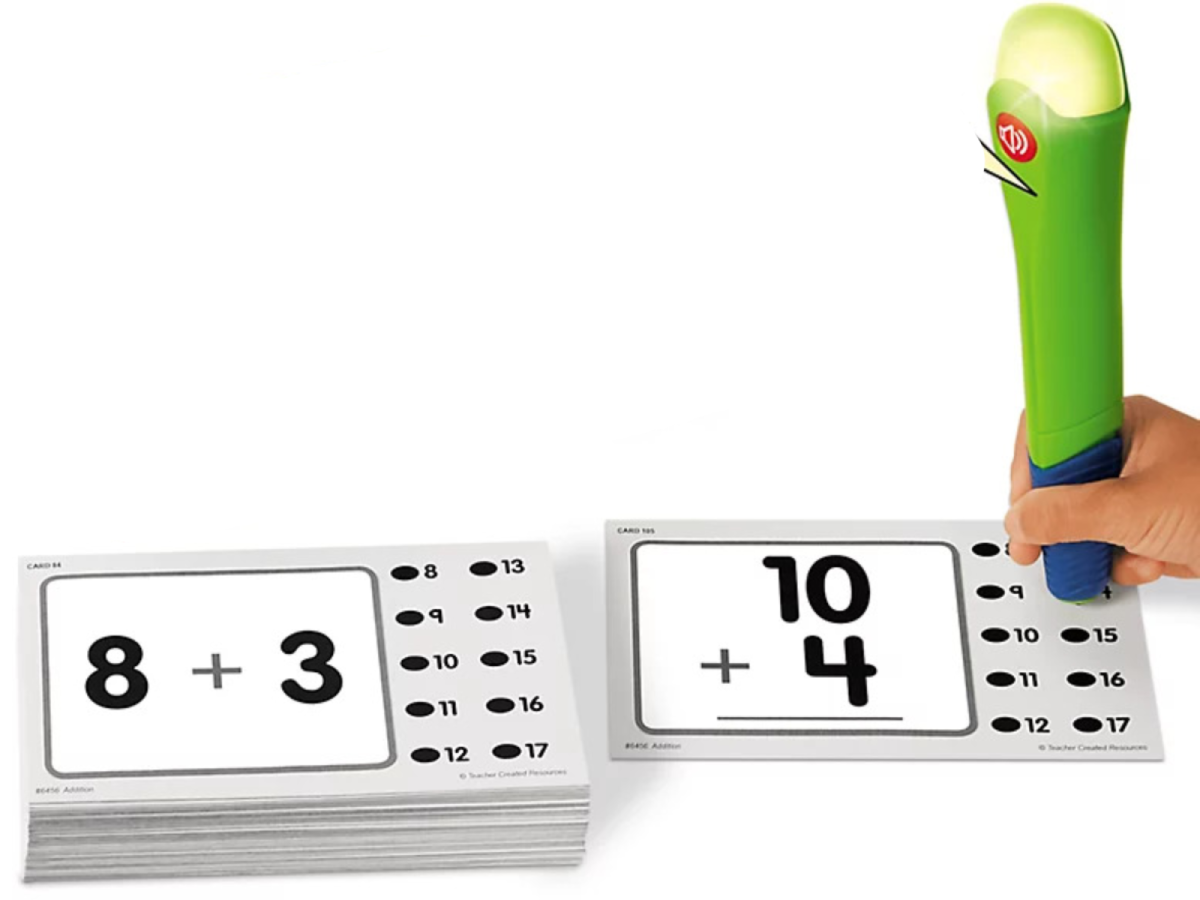
★★★☆☆
For Teachers| Age: 7-8 | 1-4 Players | Game duration: 15 minutes
In Addition Power Pen! Quiz Cards , children use a special pen to point to the answer on the card. The pen lights up when the answer is correct.
, children use a special pen to point to the answer on the card. The pen lights up when the answer is correct.
The set comes with 53 double-sided cards (106 questions) and an answer key. So your child can still use this set without the pen.
I like this card set because they are easy to use and organize. Teachers may also arrange the cards according to difficulty. It is also a great reinforcement activity for students in kindergarten up to 2nd grade, but it is more fun for first graders.
Super Genius- Addition (Blue Orange)

★★★★★
For Parents and Teachers | Age 7+ | 1-4 Players| Game duration: 15 minutes
Super Genius-Addition is a matching card game where players must pair up SUM cards and EQUATION cards. Each card contains five equations or five sums.
is a matching card game where players must pair up SUM cards and EQUATION cards. Each card contains five equations or five sums.
This game is ideal for beginners because it does not have a set time limit. But it can also make the gameplay longer. Other pros of this card set are:
- The cards are easy to use
- The game is engaging and encourages concentration
- Useful in the classroom because of its flexible rules
- There are several ways to play them
Although the set’s design is simple, the numbers are readable.
I recommend Super Genius-Addition because of its replay value.
Other Types of Addition and Subtraction Games
For more addition and subtraction games, you might want to read my other posts:
- 15 Addition and Subtraction Card Games for PreK to 5th Graders

- 13 Addition and Subtraction Board Games for PreK to Grade 3

- 11 Addition and Subtraction Puzzles for Preschoolers to Grade 2

Edudingo.com is a participant in the Amazon Services LLC Associates Program, an affiliate advertising program designed to provide a means for sites to earn advertising fees by advertising and linking to Amazon.com. We also participate in other affiliate programs which compensate us for referring traffic.

